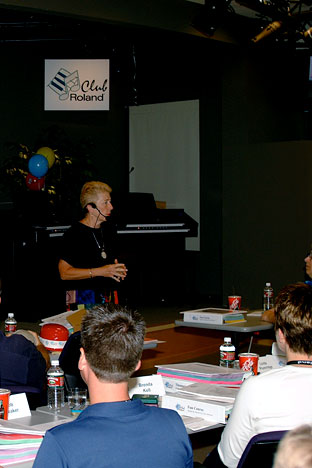Creative Solutions For Inspired Learning
Menu
Creative Solutions For Inspired Learning
MenuBy Sandy Porter, Roland Education Consultant

Several years ago I realized that I was more than a piano teacher. At the time, I was working and teaching in a retail music store, and my adult student population began to grow. While I thoroughly enjoyed my adult students, their musical needs, wants, and desires did not necessarily coincide with my traditional piano background. It dawned on me that although I was teaching piano, I was also in the health and wellness industry, providing my students with health and happiness through music.
This idea changed my whole concept of teaching. I began to listen to the musical dreams of my adult students, and they weren’t necessarily the same as my dreams for them. Here are just some of their comments to me:
Many of these people had come to me through short-term (6-12 week) introductory EZ Play classes. EZ Play generally means playing one note in the right hand and one or two notes in the left hand, with a background of orchestrated sounds accompanying the melody. Most teachers assume that after these introductory classes, the student should move into learning how to play the right way. So, I became, by default, an EZ Play piano teacher. Today, after nine years of EZ Play teaching, I can tell you that it is the most rewarding teaching I have ever done, and not because I have created great musicians.
However, these are the questions I had to answer for my own comfort level.
The answer is very easy—because it gives tremendous fulfillment to many lives. As a musical health care or wellness provider, I now clearly understand that any way that students play that gives them pleasure is valid. It is not my right as a teacher to say that there is only one correct way to play. The benefits of playing music are mental, emotional, psychological, and physical. Why should I teach EZ Play? Because I’ve added a new and ever-expanding group of adults to those people who enjoy playing music.
When the students ask for it, or it is clear that they will be encouraged by a method that gives them instant gratification. I teach EZ Play to give adults a “jump start.” I then allow them to decide whether they stay with EZ Play or move to a more traditional method. EZ Play concepts are musically correct, so students don’t have to “unlearn” anything if they move to traditional lessons. In addition, many of my adults who are in the “senior” age range find that EZ Play is as much as they physically can handle.
Since it is not a traditional method of teaching, there are no guidelines. Just do whatever it takes to ensure your students enjoy their lessons.
Some things my lessons include are:
EZ Play students can be taught in groups or privately. I have a class of four students that have met as a group for nine years. They have chosen to remain in EZ Play books that interest them. Each one of them is at a totally different level. They tell me they enjoy the social aspect, the sense of self-satisfaction, and the lack of pressure to perform at a certain level. During these nine years, we have studied chords, rhythm, fingering, phrasing, registration, forms of pop music, and how to get the most out of their particular electronic instrument.
One of my private EZ Play students began lessons at the age of 62. She was adamant that she did not want traditional lessons, and that all she ever wanted to play was EZ Play music. She is very talented and in two years (with gentle prodding from me) has learned how to play chords in the right and left hand, how to play with great rhythmic and expressive accuracy, how to pedal properly, and how to do her own intricate orchestrations and registrations. She recently was the accompanist at a friend’s wedding. But she still has no interest in traditional lessons. I think it would have been a tragedy for her not to play because she didn’t want traditional lessons. I consider her one of the best students I have ever had, and the joy she receives from playing the piano is truly beyond any measurement that I know.
I am not advocating that all adult students take EZ Play music lessons. I am advocating that adult students should have a choice in how they want to play, and that EZ Play should be one of those choices. As our population continues to age and more seniors are leading active lifestyles, won’t you give them an opportunity to enjoy playing music? Consider adding EZ Play as an option in your teaching.